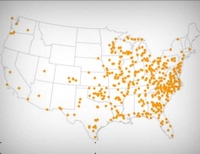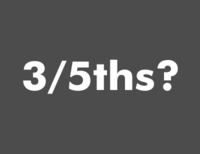Using the Census Bureau’s PL94-171 Group Quarters Population Table
What you can do with this data, what you can't do, and how you can fill in the gaps.
by Aleks Kajstura, last updated February 3, 2025
Prison gerrymandering is the result of two related, but distinct, problems that require two separate solutions. First, the Census Bureau counts incarcerated people as residents of the wrong location (at the prison). Second, the Census Bureau fails to count incarcerated people as residents of the correct location (at their homes).
This memo concerns fixing the first half of the problem: finding the prisons in the Census data. Mathematically, counting incarcerated people at the prison location has a larger vote dilutive effect than simply failing to count them at the correct home address. This half of the problem is not only most important, it is also surprisingly difficult for data users to fix without Census Bureau cooperation. (Because of how the Census is conducted and the data tabulated by block, it can be difficult — even with external data from the prison system — to deduce how much of each block is incarcerated. This was sometimes possible in individual blocks, but not always, and generally not possible state-wide.)
All of this is made more complicated by the fact that the Census Bureau publishes data not for individual addresses or institutions, but aggregated to the approximately 11 million Census “blocks.” In an urban area, a block might be a city block, but particularly in rural areas the shapes can look quite arbitrary and contain a mix of institutional and residential land.
The Census Bureau has always published block level counts of people in “group quarters,” which includes prisons, but this data has traditionally not been available until the summer of the year after the Census when a file called Summary File 1 is published. Unfortunately, Summary File 1 is published too late to be useful for most redistricting. During the 2000 redistricting cycle, most counties and municipalities that wished to avoid prison gerrymandering by removing the prison populations before redistricting had to rely on creative methods that weren’t precise enough for state-wide use.
While as advocates, we have long argued for the Census Bureau to count incarcerated people at their home addresses, the Census Bureau has so far refused to make that improvement. But the Census Bureau acknowledged government bodies drawing districts need to know where the prisons are located in Census data in order to make their own decisions about removing these populations or reallocating them elsewhere. Therefore, the Bureau made a critical technical change to the 2010 Census that it will build upon in 2020. For the 2010 cycle, the Bureau published an Advance Group Quarters Summary File on April 20, 2011. This was after the redistricting data for each state was available, but months earlier than these data tables would have been available in Summary File 1. For 2020, the Census Bureau is going even further and publishing the Group Quarters data as table P5 within the PL94-171 redistricting data made available to each state. (The PL91-171 data would normally be released in February or March 2021, but the pandemic may force Congress allow the Bureau a small extension to the end of July 2021.)
In the 2020 redistricting cycle, ten states will be using these data in combination with their own home address data to count incarcerated people at home for redistricting purposes. These states will thus solve both of the problems outlined above; incarcerated people will not be counted at the prison location, and they will be counted at home. (For a detailed account of how states implemented this population adjustment in the 2010 redistricting cycle, see Implementing Reform: How Maryland & New York Ended Prison Gerrymandering)
In addition, we estimate that over 200 counties and municipalities will use the Census Bureau’s group quarters table to solve just the first part of the problem; they will adjust redistricting data in a way that avoids padding the districts that contain prison populations, but does not count incarcerated people at their home addresses.
Data structure and new release schedule
For the first time, each state’s PL 94-171 redistricting data file from the Census will include block level counts of the group quarters population.
By law, the redistricting data, often referred to by the statute that required its creation, PL94-171, must be made available to the states by April 1, 2021. In practice, the Census Bureau traditionally releases it in waves starting in February. But this decade, the pandemic may force the Census Bureau to delay publication as late as July 31, 2021. This PL94-171 data is a subset of the larger Census data, and contains only 6 tables of information needed for redistricting: total population by race, total population by ethnicity, population 18 or over by race population 18 or over by ethnicity, housing occupancy, and group quarters populations.
The new table will officially be designated as P5 and called “Group Quarters Population by Group Quarters Type”.
What you will find in the PL 94-171 Group Quarters Table 5:
- For each of the ~11 million census blocks, the number of people in:
- Correctional facilities for adults (P0050003)
- Juvenile facilities (P0050004)
- Nursing/skilled care facilities (P0050005)
- Other institutionalized facilities (P0050006)
- College/university student housing (P0050008)
- Military quarters (P0050009)
- Other non-institutional facilities (P0050010)
The Group Quarters Table won’t have everything:
- No home addresses of people counted in group quarters.
- No names of facilities. (See below for a partial solution.)
- No indication whether each block contains one correctional facility or multiple facilities. (See below for a partial solution.)
- No indication of the types (prison, jail, private, etc.) of facilities. (See below for a partial solution.)
- No data on race/ethnicity/age (Although it may be possible to generate close estimates of race/ethnicity/age immediately if the correctional population is similar to the total population of the block, and possibly other estimates if you can wait until your states’ Demographic and Housing Characteristic File is available (see below).)
- No other demographic information.
The Census Bureau may also be publishing other relevant tables in mid or late 2021 that may be relevant for addressing prison gerrymandering if they are published in time. The Bureau has not made a final announcement of which tables will be included in the Demographic and Housing Characteristics File (previously called Summary File 1), and the publication of this file may be delayed beyond the expected dates of June to August 2021 because of the pandemic. We’ll update this documentation when we know more, but we’ll be looking to see the Bureau’s plans for potentially helpful tables like:
- Sex by age (<18, 18-64, 65+) for the adult correctional population may be in a table tentatively numbered P15 Group Quarters Population By Sex By Age By Major Group Quarters Type. (The equivalent 2010 table was Summary File 1, P43.)
There are also some tables produced for 2010 Census Summary File 1 that we expect will not be available in 2020. Data users who used these tables will need to develop other solutions:
- 2010 Summary File 1 PCT21 Group Quarters Population By Sex By Age By Group Quarters Type which contained group quarters subtype information (ie federal prison, state prison, local jail) is not expected to be published in 2020 except at the state level in table PST1, and therefore will be not useful for making tract-level redistricting decisions. This change should not be critical because the Prison Policy Initiative will again be annotating most of the census blocks that contain correctional facilities with the type of the facility, although of course it was helpful to have this data from the Census Bureau where it was available.
- 2010 Summary File 1 PCT20A to PCT20I Group Quarters Population By Major Group Quarters Type for nine combinations of race and ethnicity is not expected to be published in 2020 except at the county level in tables PCO29A through PCO29I, and will therefore not be useful for making tract-level redistricting decisions.
- 2010 Summary File 1 P29A-I Household Type by Relationship for nine combinations of race and ethnicity is not expected to be published in 2020 except at the county level in tables PCO28A-I.
- 2010 Summary File 1 PCT20 Group Quarters Population by Group Quarters Type which had counts by group quarters subtype (ie federal prison, state prison, local jail) is not expected to be published in 2020.
- 2010 Summary File 1 P42 Group Quarters Population by Major Group Quarters Type is not expected to be published in 2020. But this data will be available at the block level in P5, which will be published in the PL data release.
What the Prison Policy Initiative will be providing to further support data users:
Avoiding prison gerrymandering means having access to the data to know whether the proposed districts contain large correctional facilities, whether those correctional facilities are likely to contain people from outside of that district, and whether the presence of the correctional institutions will change how opportunity districts perform. The Prison Policy Initiative is publishing resources to help:
- A short primer on determining which types of correctional facilities are most relevant to correcting prison gerrymandering.(Originally prepared as a sidebar to a report about Oklahoma, this explanation of who is in different types of facilities and why states may want to treat different facility types differently should helpful in most states.)
- Annotations of the Census Bureau’s prison count data to help line drawers identify facilities of different types. We’ll be making these — and other — annotations available in a variety of tables and digital mapping formats within days of the data’s release by the Census Bureau. See our data page for a full list and schedule.
- A primer with some suggestions on different ways to determine whether correctional facilities are impacting the published race and ethnicity data for your districts. (Coming in winter 2020, depending on when the Bureau publishes the final list of tables in the Demographic and Housing Characteristic File.)
Conclusion
The Census Bureau’s decision to include the Group Quarters population table in the PL94-171 file is a huge step forward that will give communities more choices about how to draw their districts.
As this article describes, the Group Quarters table has limitations, but with advance planning line drawers can minimize the impact of those limitations, and draw better districts to minimize the effect of prison gerrymandering in this round of redistricting. We continue to work to convince the Census Bureau to eliminate prison gerrymandering by counting incarcerated people at their home addresses.
Events
- April 30, 2025:
On Wednesday, April 30th, at noon Eastern, Communications Strategist Wanda Bertram will take part in a panel discussion with The Center for Just Journalism on the 100th day of the second Trump administration. They’ll discuss the impacts the administration has had on criminal legal policy and issues that have flown under the radar. Register here.
Not near you?
Invite us to your city, college or organization.



